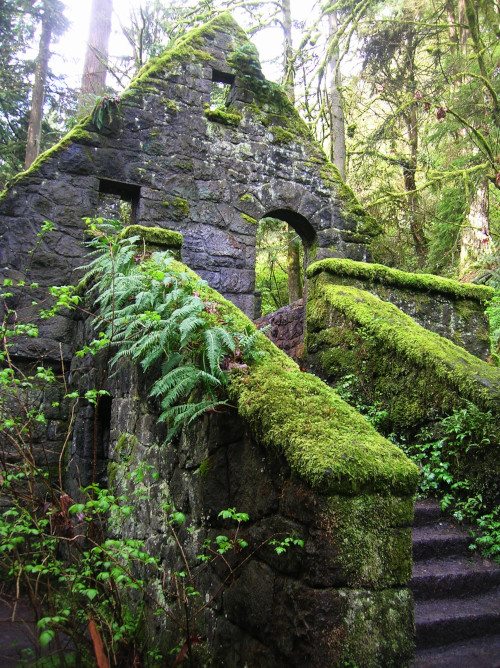At more than 5,000 acres, Portland’s Forest Park is one of the largest urban parks in America. Encompassing an eight–mile-long swath of the rolling Tualatin Mountains, Forest Park makes up Portland’s western emerald backdrop. The park is a hiking and trail running haven with more than 70 miles of trails. Consisting primarily of thick second- and third-growth forest on gentle ridges, much of Forest Park’s landscape is pretty monotonous. However, where Balch Creek slices through the Tualatin Mountains creating a deep ravine, the scene is dramatically different. Here you’ll find waterfalls, old-growth groves, and the ruins of an eloquent old stone building—along with a storied past.
Balch Creek flows for about 3.5 miles from the Tualatin Mountains to the Willamette River. Its upper reaches remain in a fairly natural state, while its lower reaches flow mainly through pipes and channels in one of Portland’s most heavily industrial areas. The creek once flowed into large, shallow Guilds Lake on the river’s floodplain, but that lake succumbed to filling and draining and is now a distant memory.
Danford Balch, the settler whose name graces this creek, has a place in Oregon’s history, but not in a celebrated fashion. Balch was not too happy with a neighbor who eloped with one of his daughters. He shot and killed his future son-in-law and on October 17, 1859 went down in Oregon history as the first person hanged by the new state.
A more notable Portlander is Scot Donald Macleay. In 1897 this prominent Portland businessman and proud Scot, gave the city of Portland a sizeable chunk of property in commemoration of Queen Victoria’s 60th year of reign—and in protest of high property taxes! He’d rather his land become a park than to pay the high taxes on it. Portland’s first major park however came with a couple of provisions, one which stated, “the city shall provide conveyance for carrying patients from area hospitals through the park during the summer.” Paths were subsequently widened to accommodate wheelchairs, and the first .3 mile (.5 km) of this trail along Balch Creek is now paved for universal access. Macleay Park has since been absorbed into the greater Forest Park complex, being one of the more attractive parts of this sprawling backyard wilderness.
To start exploring Macleay’s legacy, head up the trail and immediately pass beneath the attractive (and recently rehabilitated) Balch Gulch Bridge. This bridge which NW Thurman Street traverses was built in 1905 during the Lewis and Clark Centennial Exposition and Worlds Fair. It’s one of the oldest intact bridges in the area and one of a just a few of its type remaining in the country.
At the bridge, reach Balch Creek disappearing into an olden wooden catch. Downstream from here the creek is submerged beneath industrial flats to the Willamette River. Upstream, it’s a delightful bubbling waterway. Cross the creek entering the heavily wooded canyon. Pavement soon ends yielding to a natural surface. Continue upstream passing charming little falls and rapids. Cross the creek once more at a pretty little waterfall. Take time to notice the forest too—some of Portland’s biggest and oldest trees adorn this canyon, including a massive Douglas-fir, an official City of Portland Heritage Tree. At .9 mile (1.4 km) reach the 30-plus mile (50-plus km) long Wildwood Trail at the remains of an old stone house.
Recently marred with graffiti (please report any acts of vandalism you witness), this intriguing and eloquent building will have you pondering its origin. Was it an inn? Perhaps a country cottage or estate? A tea house? Nope, it was actually a pee house! Built by the Depression-era Works Project Administration (WPA) in 1936, this old stone house served as a public restroom until 1962. A favorite spot for photographers, it has recently been under attack by vandals with cans of spray paint. Many area residents are worried that this charming and historically significant landmark may be lost and they are calling on the parks department to clean it up—and for the public to better respect it.
After you admire this unique structure, continue hiking straight on the Wildwood Trail upstream for another .3 mile (.5 km) to a bridge crossing over Balch Creek. From here the trail climbs out of the canyon to soon reach NW Cornell Road (alternative start for this hike with more parking spaces) making this a logical turning around spot. Now head downstream and enjoy the ravine once more.
Photo credits: all photos courtesy of Craig Romano.
Craig Romano is an award-winning author of more than twenty hiking guidebooks. For more details on this hike and other exceptional hikes within Portland and along the Columbia River, pick up a copy of his Day Hiking Columbia River Gorge (Mountaineers Books).

Location: Forest Park, Portland, Oregon
Distance: 2.4 miles (3.9 kilometers) roundtrip
Elevation gain: 300 feet (91 m)
Difficulty: easy
Trail notes: kid-friendly; dogs must be leashed; practice Leave No Trace principles.
Trail highlights: old growth forest and wild ravine minutes from downtown Portland. Historic structures and colorful historic background.
Contact: Portland Parks and Recreation
Getting to the trail: From Portland; follow NW Vaughn Street west (access from Exit 3 off of I-405 (US 30 exit) to NW Vaughn Street) turning left onto NW 26th Ave. After one block, turn right onto NW Upshur Street and continue .4 mile (0.6 km) to road’s end at trailhead at Lower Macleay Park. Limited parking—consider taking TriMet Line 15 to stop on NW Thurman Street and 29th Ave and walk 0.1 mile (.16 km) to trailhead.
If you found this article informative, please consider becoming a supporting reader of Cascadia Magazine. As a nonprofit publication, we depend on the generous financial support of readers like you to pay our writers and photographers a fair rate for their work. Visit out donate page to make a contribution at any level you’re comfortable with.
And if you’re already a supporting reader, thank you!
